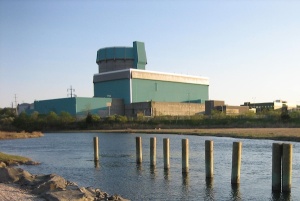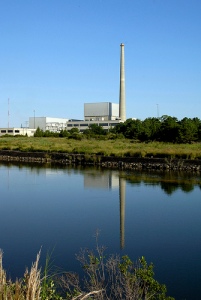Head of Long Island Power Authority Steps Aside as Governor Convenes Special Commission, But Problems Have Deep Roots

The decommissioned Shoreham Nuclear Power Plant still occupies a 58-acre site on Long Island Sound. (photo: Paul Searing via Wikipedia)
As the sun set on Veterans Day, 2012, tens of thousands of homes on New York’s Long Island prepared to spend another night in darkness. The lack of light was not part of any particular memorial or observance; instead, it was the noisome and needless culmination of decades of mismanagement and malfeasance by a power company still struggling to pay for a now-moldering nuclear plant that never provided a single usable kilowatt to the region’s utility customers.
The enterprise in charge of all that darkness bears little resemblance to the sorts of power companies that provide electricity to most Americans–it is not a private energy conglomerate, nor is it really a state- or municipality-owned public utility–but the pain and frustration felt by Long Island residents should be familiar to many. And the tale of how an agency mandated by law to provide “a safer, more efficient, reliable and economical supply of electric energy” failed to deliver any of that is at its very least cautionary, and can likely serve as an object lesson for the entire country.
Almost immediately, the United States will be faced with tough choices about how to create and deliver electrical power. Those choices are defined not just by demand but by a warming climate and an infrastructure already threatened by the changes that climate brings. When one choice, made by a private concern nearly 50 years ago, means weeks of power outages and billions of dollars in repair costs today, it suggests new decisions about America’s energy strategy should be handled with care.
A stormy history
Two weeks after Hurricane-cum-Superstorm Sandy battered the eastern coast of the United States, upwards of 76,000 customers of the Long Island Power Authority (LIPA) were still without power. That number is down markedly from the one million LIPA customers (91 percent of LIPA’s total customer base) that lost power as Sandy’s fierce winds, heavy rains and massive storm surge came up the Atlantic Coast on Monday, October 29, and down, too, from the over 300,000 still without service on election day, but at each step of the process, consumers and outside observers alike agreed it was too many waiting too long.
And paying too much. LIPA customers suffer some of the highest utility rates in the country, and yet, the power outages that came with last month’s storm–and a subsequent snowstorm nine days later–while disgraceful, were far from unexpected. The Long Island Power Authority and its corporate predecessor, the Long Island Lighting Company (LILCO), have a long track record of service failures and glacial disaster response times dating back to Hurricane Gloria, which hit the region in the autumn of 1985.
After Gloria, when many Long Island homes lost power for two weeks, and again after widespread outages resulted from 2011’s Hurricane Irene, the companies responsible for providing electricity to the residents of most of Nassau and Suffolk Counties, along with parts of the Borough of Queens in New York City, were told to make infrastructure improvements. In 2006, it was reported that LIPA had pledged $20 million annually in grid improvements. But the reality proved to be substantially less–around $12.5 million–while LIPA also cut back on transmission line inspections.
Amidst the current turmoil, New York Governor Andrew Cuomo has been highly critical of LIPA, calling for the “removal of management” for the “colossal misjudgments” that led to the utility’s failures. Cuomo made similar statements about LIPA and its private, for-profit subcontractor, National Grid, last year after Hurricane Irene. But as another day mercifully dawned on tens of thousands of homes still without electricity over two weeks after Sandy moved inland, the dysfunctional structure in charge of the dysfunctional infrastructure remains largely unchanged.
Which, it must be noted, is especially vexing because Governor Cuomo should not be powerless when it came to making changes to the Long Island Power Authority.
It was Andrew’s father, Governor Mario Cuomo, who oversaw the creation of LIPA in 1985 to clean up the fiscal and physical failures of the Long Island Lighting Company. LILCO’s inability to quickly restore power to hundreds of thousands of customers after Hurricane Gloria met with calls for change quite similar to contemporary outrage. But it was LILCO’s crushing debt that perhaps exacerbated problems with post-Gloria cleanup and absolutely precipitated the government takeover.
The best-laid schemes
It was April 1965 when LILCO’s president announced plans for Long Island’s first commercial nuclear power facility to be built on Long Island Sound near the town of Brookhaven, already home to a complex of research reactors. The 540-megawatt General Electric boiling water reactor (similar in design to those that failed last year in Japan) was estimated to cost $65 million and come online in 1973.
The price of the Shoreham nuclear project quickly ballooned, first, as LILCO proposed additional reactors across Long Island–none of which were ever built–and then as the utility up-rated the original design to 820 megawatts. Further design changes, some mandated by the Nuclear Regulatory Commission, and construction delays pushed the price tag to $2 billion by the late 1970s.
Because of its proximity to the Brookhaven reactors, LILCO expected little public activism against Shoreham, but local opposition steadily grew throughout the ’70s. The Sierra Club, the Audubon Society and environmentalist Barry Commoner all raised early objections. After a meltdown at Pennsylvania’s Three Mile Island nuclear plant in 1979, Shoreham saw 15,000 gather in protest outside its gates, an action that resulted in 600 arrests.
Three Mile Island led to new NRC rules requiring nuclear facilities to coordinate with civic authorities on emergency plans for accidents necessitating the evacuation of surrounding communities. LILCO was forced to confront the fact that, for Shoreham, the only routes for evacuation were already clogged highways that bottlenecked at a few bridges into Manhattan, 60 miles to the west.
In 1983, the government of Suffolk County, where Shoreham was located, determined that there was no valid plan for evacuating its population. New York Governor Mario Cuomo followed suit, ordering state regulators not to approve the LILCO-endorsed evacuation plan.
Still, as Shoreham’s reactor was finally completed in 1984, 11 years late and nearly 100-times over budget, the NRC granted LILCO permission for a low-power test.
But 1985’s Hurricane Gloria further eroded trust in LILCO, and the next year, the Chernobyl disaster further galvanized opposition to a nuclear plant. As LILCO’s debts mounted, it became apparent that a new structure was needed to deliver dependable power to Long Island residents.
The power to act
The Long Island Power Act of 1985 created LIPA to assume LILCO’s assets, and a subsidiary of this municipal authority, also known as LIPA, acquired LILCO’s electric transmission and distribution systems a year later. The radioactive but moribund Shoreham plant was purchased by the state for one dollar, and later decommissioned at a cost of $186 million. (Shoreham’s turbines were sent to Ohio’s Davis-Besse nuclear facility; its nuclear fuel was sent to the Limerick Nuclear Power Plant, with LILCO/LIPA paying Philadelphia Electric Company $50 million to take the fuel off its hands.)
The $6 billion Shoreham folly was passed on to consumers in the form of a three-percent surcharge on utility bills, to be charged for 30 years. Service on LILCO’s $7 billion in debt, half of which is a direct result of Shoreham, makes up 16 percent of every LIPA bill.
But LIPA itself is not really a utility company. Its roughly 100 employees are low on public utilities experience and, as the New York Times reports, high on political patronage. The majority of LILCO’s non-nuclear power plants were sold to a newly created company called KeySpan (itself a product of a merger of LILCO holdings with Brooklyn Union Gas), and maintenance of LIPA’s grid was subcontracted to KeySpan.
KeySpan was in turn purchased by British power company National Grid in 2006.
The situation is now further complicated, as National Grid lost out to Public Service Enterprise Group, New Jersey’s largest electricity provider, in a bid to continue its maintenance contract. PSEG takes over the upkeep of LIPA’s grid in 2014.
A commission on transmission
On Tuesday, Governor Cuomo the Younger announced formation of a Moreland Commission–a century-old New York State provision that allows for an investigative body with subpoena power–to explore ways of reforming or restructuring LIPA, including the possibility of integrating with the state’s New York Power Authority. And just hours later, LIPA’s COO and acting CEO, Michael Hervey, announced he would leave the utility at the end of the year.
But the problems look more systemic than one ouster or one commission, no matter how august, can correct. Andrew Cuomo’s inability to appoint new LIPA board members could owe as much to entrenched patronage practices as to political pre-positioning. State Republicans, overwhelmingly the beneficiaries of LIPA posts, are engaged in a behind-the-scenes standoff with the Democratic Governor over whom to name as a permanent LIPA director. Others see Cuomo as too willing to accept the political cover conveyed by not having his appointees take control of the LIPA board.
Still, no matter who runs LIPA, the elaborate public-private Russian-doll management structure makes accountability, not to mention real progress, hard to fathom. Perhaps it would be crazy to expect anything but regular disasters from a grid maintained by a foreign-owned, lame-duck, for-profit corporation under the theoretical direction of a leaderless board of political appointees, funded by some of the highest electricity rates in the country. And those rates, by the way, are not subject to the same public utilities commission oversight that would regulate a private utility, nor do they seem sensitive to any democratic checks and balances.
And all of this was created to bail out a utility destabilized by the money pit that is nuclear power.
The truth has consequences
As nighttime temperatures dip below freezing, it will be cold comfort, indeed, for those still without the power to light or heat their homes to learn that money they have personally contributed to help LIPA with its nuclear debt could have instead paid for the burying of vulnerable transmission lines and the storm-proofing of electrical transformers. But the unfortunate results of that trade-off hold a message for the entire country.
It was true (if not obvious) in 1965, it was true in 1985, and it is still true today: nuclear power, beyond being dirty and dangerous, is an absurdly expensive way to generate electricity. This is especially apropos now, in the wake of a superstorm thought to be a harbinger of things to come as the climate continues to warm.
In recent years, the nuclear industry has latched on to global warming as its latest raison d’être, claiming, quite inaccurately, that nuclear is a low-greenhouse gas answer to growing electrical needs. While the entire lifecycle of nuclear power is decidedly not climate friendly, it is perhaps equally as important to consider that nuclear plants take too long and cost too much to build. The time, as well as the federal and consumer dollars, would be better spent on efficiency, conservation, and truly renewable, truly climate-neutral energy projects.
That is not a hypothetical; that is the lesson of LIPA, and the unfortunate reality–still–for far too many New York residents.


You must be logged in to post a comment.